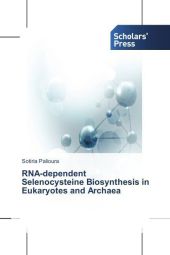 Neuerscheinungen 2014Stand: 2020-02-01 |
Schnellsuche
ISBN/Stichwort/Autor
|
Herderstraße 10
10625 Berlin
Tel.: 030 315 714 16
Fax 030 315 714 14
info@buchspektrum.de |

Sotiria Palioura
RNA-dependent Selenocysteine Biosynthesis in Eukaryotes and Archaea
2014. 108 S. 220 mm
Verlag/Jahr: SCHOLAR´S PRESS 2014
ISBN: 3-639-70903-9 (3639709039)
Neue ISBN: 978-3-639-70903-2 (9783639709032)
Preis und Lieferzeit: Bitte klicken
Selenocysteine (Sec), the 21st genetically encoded amino acid, is the major metabolite of the micronutrient selenium. Sec is inserted into nascent proteins in response to a recoded UGA stop codon. The substrate for ribosomal protein synthesis is selenocysteinyl-tRNA. The mechanism of Sec-tRNA formation was known in bacteria, but remained poorly understood in archaea and eukaryotes. Herein, biochemical and genetic data provide evidence that Sec-tRNA biosynthesis requires the tRNA-dependent conversion of O-phosphoserine (Sep) to Sec in eukaryotes and archaea. In this two-step pathway O-phosphoseryl-tRNA kinase (PSTK) first converts seryl-tRNA to Sep-tRNA, which is then the obligatory precursor for a Sep-tRNA: Sec-tRNA synthase (SepSecS). SepSecS used to be annotated as Soluble Liver Antigen/Liver Pancreas (SLA/LP) and is thought to be the antigen for a form of autoimmune hepatitis. The crystal structure of human SepSecS complexed with its substrates sheds light to the vitamin B6-dependent mechanism of Sec-tRNA formation. This report is useful to biophysicists, biochemists, and evolutionary biologists as well as to anyone investigating the role of SepSecS in autoimmune hepatitis.
Sotiria Palioura, MD, PhD: A native of Greece, Sotiria graduated magna cum laude from Yale College with both BSc and MSc degrees in Biophyscis & Biochemistry (2003). She then earned an MD and a PhD in Molecular Biophysics and Biochemistry at Yale University School of Medicine (2010). She is now a resident in Ophthalmology at Harvard Medical School


